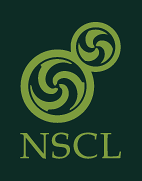Advice for Proposal Preparation
During a proposal cycle, the Laboratory also accepts Letters of Intent. A spokesperson might choose to submit a Letter of Intent if they have an idea for a proposal, but a significant new development is necessary, for example, new equipment, a new primary beam, or new ReA3 beam development. Confirmation by the PAC of the priority for the science described can help justify the needed developments. A Letter of Intent can be much shorter than a full proposal, and doesn’t require all of the facility worksheets for a full proposal. The spokesperson of a Letter of Intent would receive feedback from the PAC on how a proposal for the science described might be received in the future and may receive guidance on what would be expected in a full proposal.
Normally, users will submit a full proposal. Linked here are two examples of proposals that were approved during a previous PAC and illustrate the content necessary for a successful proposal (Proposal 12029 and Proposal 12007). After proposals are submitted, they go through a technical and safety review by NSCL Laboratory staff. The purpose of the reviews is to assess if the proposed experiments are within the established technical capabilities and safety envelope of the NSCL. The spokesperson will be sent any comments from the reviews, and the spokesperson will have a chance to respond to those comments before both are sent to the PAC members.
While PAC members read every proposal, each proposal is assigned a PAC member specialist and backup specialist to review the proposal in detail. The specialist and backup specialists are assigned by the PAC Administrator and the NSCL Director based on the scientific content of the proposal and the PAC member’s field of expertise. To avoid a conflict of interest, a PAC member who is on a particular proposal would never be assigned as specialist or backup specialist to that proposal. Spokespeople will be informed of who was assigned as specialists for their proposal. The spokesperson is encouraged to contact the specialist with clarifications, afterthoughts, etc. or alternatively, the spokesperson may be contacted by the specialist for further information. On all communication, please copy Jill Berryman, the PAC Administrator, who keeps a record.
During the PAC meeting, each proposal is discussed individually. The specialist and backup specialist give a summary of the proposal, and then the floor is open for further discussion. To avoid any conflict of interest, any PAC member who is a collaborator on the proposal must leave the room during the proposal evaluation. The PAC rates proposals according to their scientific merit and educational value. Small differences in the ratings can affect whether a proposal is recommended for beam time, so care and attention to all elements of a good proposal can make a difference.
The Executive Committee of the FRIB User Organization (NSCL Operations Subcommittee) is invited to designate a representative to attend each PAC meeting as an observer. The observer may write a letter of their observations to be shared with the user community and the National Science Foundation.
The PAC makes recommendations to the NSCL Director, who decides on beam time allocation. The decision of the Director will be communicated to each spokesperson in writing, and a list of titles of the approved experiments are available online (https://publicapps.nscl.msu.edu/completedExperiments/)
Appeals of rejected proposals can be made to the NSCL Director, who may go back to the PAC for additional advice. Approval of an experiment lasts for only 24 months. An experiment that is not scheduled within this period will need to be resubmitted to the PAC for reconsideration. It is emphasized that approval is for the specific measurement proposed, with specified targets, beams, and beam energies. If the experimenters wish to change an approved experiment, permission must be obtained from the NSCL Director before the modified experiment can be performed.
Occasionally, an experiment may be approved “on reserve”, pending some type of development work. The development work may be, for example, a new beam development, a technique development, or new experimental equipment development. Every spokesperson who submits a proposal will get a letter from the NSCL Director after the PAC meeting. For those experiments that are placed “on reserve,” the letter from the NSCL Director will clearly state what needs to be done in order for the experiment to go from the “reserve” status to the “approved” status. Once the development work has been completed, the spokesperson should write a report explaining what has been done, and why they feel the experiment should be “approved”. After sending the report to the Manager for User Relations, the report will go to the NSCL Scheduling Committee for review, and finally to the NSCL Director for a final decision. It is not uncommon for additional information to be requested from the spokesperson, to aid the NSCL Director in making a final decision.



